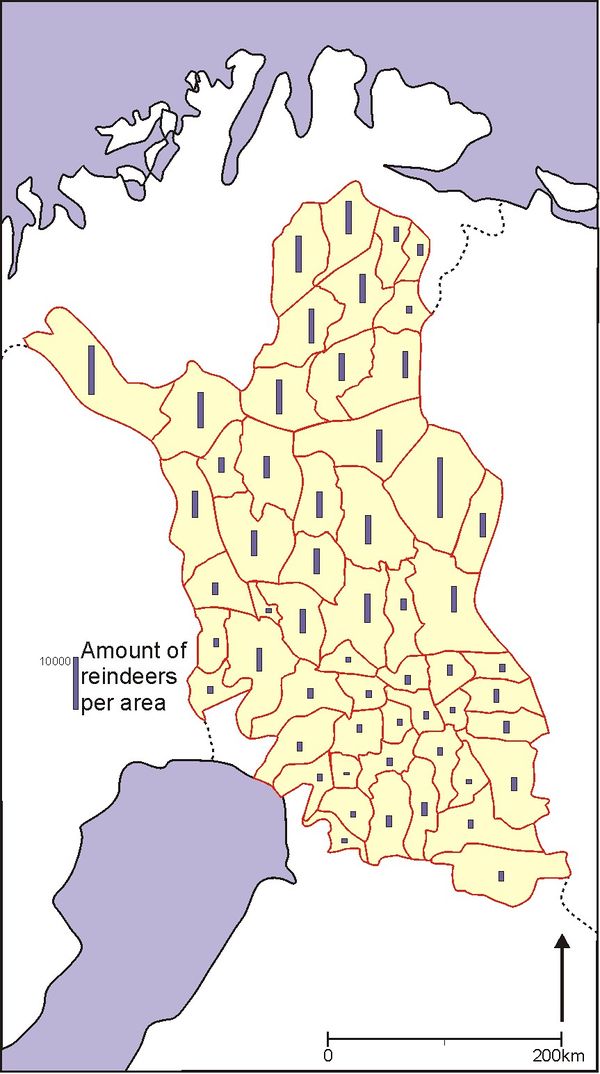Poronhoito: Suomi
Poronhoito: Suomi
Suomalaisen poronomistuksen varhaisimmat vaiheet perustuivat todennäköisesti siihen, että Perämeren rannikon vauraille talonpojille (birkarl) syntyi ainakin jo 1300-luvulla tarve käyttää poroja lähinnä eränkäyntiin, lapinverotukseen sekä pappien ja valtion virkamiesten lapinliikenteeseen. Nämä tarpeet pystyttiin tyydyttämään ensin lappalaisten poroilla, ja lappalaisia käytettiin myös työvoimana. Ennen pitkää talonpojille syntyi myös tarve omistaa poroja, jotka 1800-luvulle asti kuitenkin hoidatettiin ns. lappalaisraitioilla.
Juhani J. Kortesalmen teoria Suomen eteläisen poronhoitoalueen talonpoikaisen ja poroja hoitavan talolliskulttuurin syntymisestä on, että se kehittyi alun alkaen melko erillään tunturilappalaisesta suurporonhoidosta lähinnä itäsuomalaisen uudisasutuskulttuurin ja metsälappalaiskulttuurin sekoittuessa toisiinsa 1600-luvulla. Suomalainen poronhoito hajosi siten jo alkuvaiheessaan kahtia ja seurasi lappalaiskulttuurin jakautumista metsä- ja porolappalaiseen kulttuuriin. Eli Tornionjokilaaksoon levisi tunturisaamelainen suurporonhoitokulttuuri esimerkiksi talollisten poroja hoitaneiden lappalaisraitioiden välityksellä, mutta Kemin Lapissa rahvas alkoi hoitaa porojaan itse jo 1600-luvulla. Varsinaiseksi talonpoikaisen lihantuotantoon keskittyvän suurporonhoidon nousukaudeksi muodostuivat kuitenkin vasta 1700- ja 1800-luvut.
Kemin Lapin suomalainen poronhoito rakentuikin metsälappalaiselle pieniin poromääriin ja välilliseen tuotantoon perustuvalle kulttuuriperustalle, jossa
- porot palkivat kesäisin vapaana, minkä jälkeen
- porot koottiin syksyllä yhteisvoimin määräalueilta eli palkisilta,
- erotettiin itse kullekin poronomistajalle talven ajaksi,
- omaan käyttöön ja paimennukseen, ja jossa
- poronlypsyä ei tunnettu.
Talonpoikaisen poronhoidon palkisjärjestelmä kehittyikin metsälappalaisten porojen hakukäytänteestä ja se tunnettiin kansanomaisesti joko palkisina, poroyhtiöinä, tokkakuntina, poroliittoina tai poroseurueina. Palkinen muotoutuikin tarkoittamaan kahta käytännössä yhteen liittyvää asiaa eli
a) aluetta, jolla tietyt porot liikkuvat kesäisin ja jonne ne kokoontuvat syksyisin ilman paimennusta ja
b) poron liikkumisalueen lähinaapurustosta muodostunutta porojen kokoamisporukkaa.
Kausiluontoisista kokoamisyhtiöistä muodostui myös erilaisia aitakuntia, jotka yhteisesti rakensivat ja pitivät kunnossa metsäalueella porojen hoitamisessa tarvittavia poroaitoja.
Nykyisen Suomen alueella paliskuntiin perustuva poronhoitojärjestelmä oli kehittynyt suurimpaan osaan poronhoitoaluetta jo ennen järjestelmän lain voimaantuloa 1898. Päätöksen mukaan poronomistajien piti kuulua johonkin paliskuntaan saadakseen laiduntaa porojaan valtion mailla. Lisäksi poronhoitoalue oli jaettava paliskuntiin, joilla oli viralliset nimet, rajat ja vastuuhenkilöt, jotka yhteisöllisesti olivat vastuussa esimerkiksi porojen lukemisesta, paimentamisesta ja vahingonkorvauksista sekä toimivat muutenkin oikeuskelpoisina henkilöinä.
Vastaavana järjestelmänä Norjassa ja Ruotsissa voidaan pitää Lapinmaiden jakamista eräänlaisiin saamenkyliin, jotka jakautuvat taas pienempiin porokyliin. Järjestelmissä on kuitenkin se ero, että Ruotsissa ja Norjassa poronhoito on, muutamia erityistapauksia lukuunottamatta, rajattu saamelaisten elinkeinoksi ja saamenkylien rajat ovat muodostuneet vanhojen merenranta-sisämaa -laidunkiertojen perusteella. Venäjän poronhoito (Kuolan saamelaisten poronhoito) on taas nykyisin lähinnä käymistilassa, koska neuvostojärjestelmän porosovhoosit ja -kolhoosit ovat käytännössä vasta purkautumassa, ja tilalle on vakiintumassa erilaisia yksityis- tai osuuskuntayrittäjyyteen perustuvia poronhoitojärjestelmiä.
Poronhoito- / poro-aiheisia linkkejä: poronhoito - kokoomasivu
Reindeer husbandry: Finland
The earliest stages of reindeer ownership in Finland probably go back to the practice of rich peasants (birkarlar) living on the coast of the Gulf of Bothnia in the fourteenth century who used reindeer mainly for hunting and taxing the Saami and to their use for the transportation of priests and functionaries. The birkarlar first used the Saamis reindeer for these purposes, also employing the Saamis themselves as a source of labour. Soon, however, the peasants felt the need to possess their own reindeer, although these still continued to be tended by hired Saami herders.
According to the theory of Juhani J. Kortesalmi on the origins of reindeer husbandry in the southern peasant region of Finnish Lapland, it initially developed quite separately from the large-scale reindeer herding of the Fell Saami culture, when the cultures of the eastern Finnish settlers and the Forest Saami blended in the seventeenth century. Thus reindeer herding in Finland was divided from its inception into two separate traditions that followed the division of Saami culture into those of the Forest Saami and the Fell Saami. In other words, the large-scale reindeer herding of the Fell Saami was brought down into the Torne river valley by the Saami hired herdsmen that tended the herds of the peasants, but in the Kemi region of Lapland the common people began to herd their reindeer themselves from the seventeenth century on. However, the actual boom in the peasants large-scale reindeer husbandry for meat production did not take place until the eighteenth and nineteenth centuries.
Finnish reindeer husbandry in the Kemi region of Lapland developed out of the Forest Saami culture, which was based on small stocks and indirect production; in this culture, 1) the reindeer grazed freely in summer; 2) they were then jointly rounded up in autumn from the grazing lands; 3) they were separated for the winter into the stocks of each owner; 4) they were available for his personal use; 5) the reindeer were not milked. The pasturage system of peasant reindeer herding developed out of the round-up practice of the Forest Saami. The seasonal round-up groups also formed different kinds of corral associations that jointly maintained the corrals needed for the handling of reindeer in the area.
The reindeer husbandry system used in Finland today is based on the reindeer-grazing association (paliskunta). The system had in fact developed over most of the reindeer-herding region before it was ratified by law in 1898. The law required the reindeer owners to belong to a reindeer-grazing association in order to be permitted to graze their reindeer on state-owned land. The reindeer-herding region was divided into reindeer-grazing associations with their own official names and officers and a collective responsibility for keeping a count of the reindeer stock, herding and the liability for damage as well as other attributes of a juristic person. The system in Sweden and Norway, where Lapland is divided up into various Lapp villages , and these into smaller reindeer villages , corresponds to the Finnish one. However, the systems differ in that reindeer husbandry in Norway and Sweden is, with a few exceptions, a purely Saami activity, and the borders of the Saami villages have been formed on the basis of the old coast-hinterland grazing cycles. Reindeer herding in Russia is once more in a state of ferment because the reindeer Sovkhoz and Kolkhoz collectives of the Soviet system are still in practice being dissolved, and in their place various kinds of private and cooperative reindeer-husbandry systems are being established.
